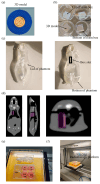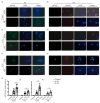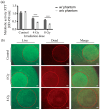Three-Dimensional-Bioprinted Non-Small Cell Lung Cancer Models in a Mouse Phantom for Radiotherapy Research
- PMID: 39408596
- PMCID: PMC11476964
- DOI: 10.3390/ijms251910268
Three-Dimensional-Bioprinted Non-Small Cell Lung Cancer Models in a Mouse Phantom for Radiotherapy Research
Abstract
Lung cancer continues to have one of the highest morbidity and mortality rates of any cancer. Although radiochemotherapy, in combination with immunotherapy, has significantly improved overall survival, new treatment options are urgently needed. However, preclinical radiotherapy testing is often performed in animal models, which has several drawbacks, including species-specific differences and ethical concerns. To replace animal models, this study used a micro-extrusion bioprinting approach to generate a three-dimensional (3D) human lung cancer model consisting of lung tumor cells embedded in human primary lung fibroblasts for radiotherapy research. The models were placed in a mouse phantom, i.e., a 3D-printed mouse model made of materials that mimic the X-ray radiation attenuation rates found in mice. In radiotherapy experiments, the model demonstrated a selective cytotoxic effect of X-rays on tumor cells, consistent with findings in 2D cells. Furthermore, the analysis of metabolic activity, cell death, apoptosis, and DNA damage-induced γH2AX foci formation revealed different results in the 3D model inside the phantom compared to those observed in irradiated models without phantom and 2D cells. The proposed setup of the bioprinted 3D lung model inside the mouse phantom provides a physiologically relevant model system to study radiation effects.
Keywords: 3D bioprinting; lung cancer; model system; mouse phantom; radiation therapy.
Conflict of interest statement
The authors declare no conflicts of interest.
Figures





Similar articles
-
Evaluating the Suitability of 3D Bioprinted Samples for Experimental Radiotherapy: A Pilot Study.Int J Mol Sci. 2022 Sep 1;23(17):9951. doi: 10.3390/ijms23179951. Int J Mol Sci. 2022. PMID: 36077349 Free PMC article.
-
Preclinical dose verification using a 3D printed mouse phantom for radiobiology experiments.Med Phys. 2019 Nov;46(11):5294-5303. doi: 10.1002/mp.13790. Epub 2019 Sep 11. Med Phys. 2019. PMID: 31461781
-
A customizable anthropomorphic phantom for dosimetric verification of 3D-printed lung, tissue, and bone density materials.Med Phys. 2022 Jan;49(1):52-69. doi: 10.1002/mp.15364. Epub 2021 Dec 2. Med Phys. 2022. PMID: 34796527
-
3D bioprinting complex models of cancer.Biomater Sci. 2023 May 16;11(10):3414-3430. doi: 10.1039/d2bm02060b. Biomater Sci. 2023. PMID: 37000528 Review.
-
3D bioprinted tumor model: a prompt and convenient platform for overcoming immunotherapy resistance by recapitulating the tumor microenvironment.Cell Oncol (Dordr). 2024 Aug;47(4):1113-1126. doi: 10.1007/s13402-024-00935-9. Epub 2024 Mar 23. Cell Oncol (Dordr). 2024. PMID: 38520648 Free PMC article. Review.
Cited by
-
Bridging the gap: how patient-derived lung cancer organoids are transforming personalized medicine.Front Cell Dev Biol. 2025 Apr 15;13:1554268. doi: 10.3389/fcell.2025.1554268. eCollection 2025. Front Cell Dev Biol. 2025. PMID: 40302940 Free PMC article. Review.
References
-
- Meagan M., Nasser H. Advances in systemic therapy for non-small cell lung cancer. BMJ. 2021;375:n2363. - PubMed
MeSH terms
Grants and funding
LinkOut - more resources
Full Text Sources
Medical

